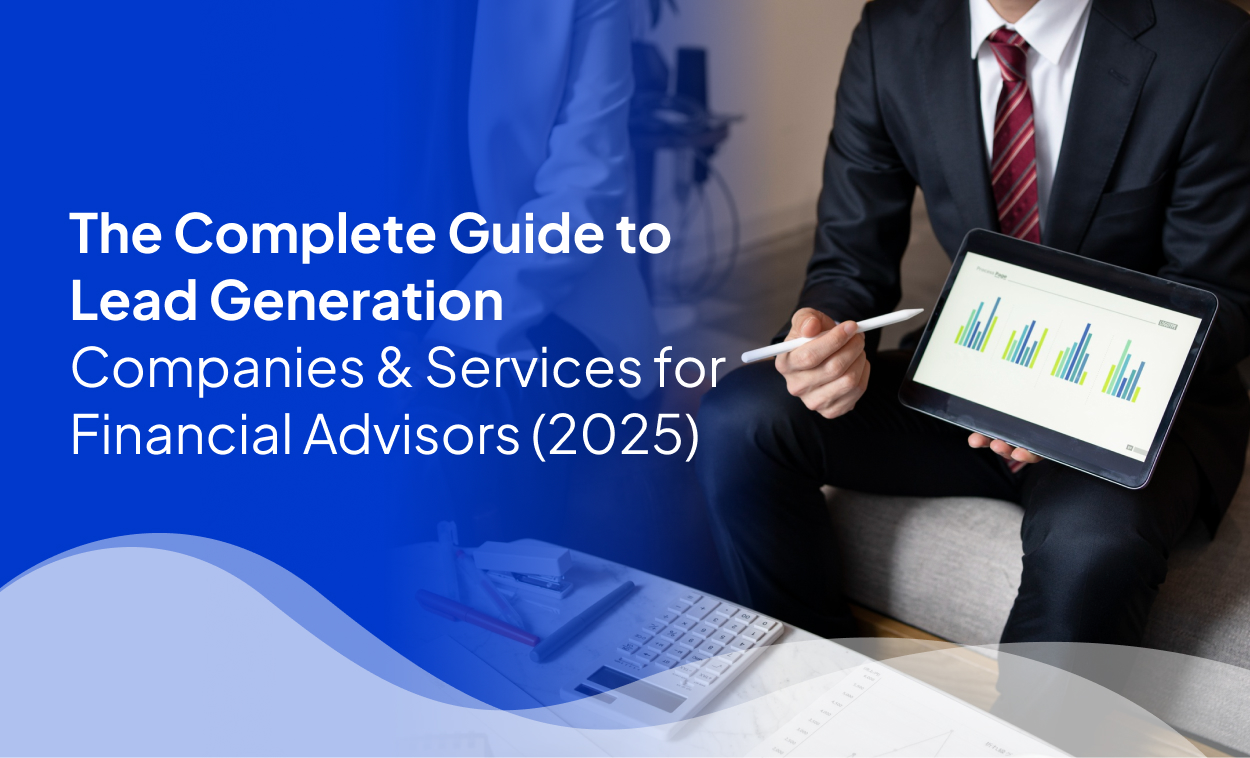
- Written & Reviewed by Jeremy
- Published
- Last Updated Sep 23, 2025
Why Content Marketing Matters for Financial Advisors
Financial market is a promising field.
With the growing complexities of careers, retirement planning, taxes, and investments, the need for financial guidance has grown more than ever.
Whether you are a veteran advisor with an established client base or a rookie looking to expand, choosing the right market is the foundation of your success.
The truth is that financial advisors are not for everyone.
Your growth depends on identifying who needs your services the most, who can afford them, and who will stay loyal for years.
To make it easier, here is a compiled list of the 10 best target markets for financial advisors in today’s world.
1. High-Net-Worth Individuals and Families
Think about executives at Fortune 500 companies, real estate investors, or successful business founders.
These individuals usually have more than one million dollars in investable assets. According to the U.S. Census Bureau, the median income for top earners is above $450,000 per year, but many HNWIs easily cross seven figures in annual income.
They need advisors for estate planning, advanced tax strategies, and managing multi-generational wealth.
These are not clients looking for cookie-cutter plans. They want bespoke strategies that protect their wealth and grow it for future generations.
2. Pre-Retirees and Retirees
This group usually consists of individuals aged 55 to 70.
Many of them have worked in corporate roles, government jobs, or owned small businesses.
Their average household income is around $70,000 to $100,000annually, but their accumulated retirement savings often range between 300,000 and 1.2 million dollars, depending on their discipline.
They want peace of mind. An advisor who helps them stretch their savings and avoid outliving their funds becomes a trusted partner.
3. Dual-Income Couples and Families with Children
These are working parents in their 30s to 50s.
They may include two professionals such as an IT manager and a nurse or a marketing consultant married to a sales director. Their combined household income often falls between 120,000 and 200,000 dollars.
Their struggles revolve around mortgages, saving for their children’s college, balancing retirement funds, and handling healthcare costs.
This group values time, so they seek advisors who can simplify decisions and structure long-term strategies.
4. Tech-Savvy Millennials and Gen Z
Millennials and Gen Z professionals work in fast-growing fields like software engineering, digital marketing, or biotech.
A software developer in Silicon Valley may earn an average of 130,000 dollars, while a marketing analyst in New York may start around 70,000 dollars.
Even though their assets are still small, they think about investing early and value socially responsible portfolios.
A 27-year-old coder working remotely may prefer cryptocurrency and ETFs, while a Gen Z content creator may ask how to turn fluctuating freelance income into structured savings.
Advisors who meet them digitally and understand apps, automation, and ESG investing can secure long-term loyal clients.
5. Single Professional Women
This is one of the fastest-growing markets. It includes women who are single by choice, divorced, or widowed.
Careers range from corporate managers earning around $ 90,000 annually to medical specialists earning over $200,000.
Advisors who respect their independence while offering empathetic guidance can build strong trust.
6. Small Business Owners and Entrepreneurs
Entrepreneurs include restaurant owners, digital agency founders, retail shopkeepers, or even independent consultants. Their incomes vary widely, from $ 70,000 for a small local business to over $ 500,000 for a growing regional brand.
A startup founder raising investment may want help separating business finances from personal wealth.
These clients think in terms of cash flow and sustainability, making them valuable long-term partners for advisors who understand both personal and business finance.
Also read – lead generation for financial advisors
7. Doctors, Lawyers, and Other Professionals
Doctors, surgeons, lawyers, and senior consultants are among the highest earners, with physicians averaging 230,000 dollars a year, specialized surgeons crossing 400,000, and attorneys at large firms between 150,000 and 250,000.
Yet high incomes do not mean financial ease. Doctors often juggle heavy student debt and malpractice insurance costs, while lawyers and consultants deal with unpredictable cash flow and rising tax obligations.
This group values precision and expects advisors who can deliver strategies tailored to their unique needs, from tax efficiency and debt management to asset protection and long-term wealth planning.
8. Federals and Military Families
Federal employees and military families represent a stable yet often underserved market for financial advisors.
Federal workers earn an average of 95,000 dollars, while military officers typically make between 70,000 and 120,000 depending on rank and service years.
Both groups have access to structured benefit systems such as the Federal Employees Retirement System (FERS), Thrift Savings Plan (TSP), pensions, and survivor benefits, yet these programs are notoriously complex.
Military families in particular face frequent relocations and the challenge of managing housing, pensions, and healthcare transitions. Advisors who understand these systems can provide clarity, optimize benefits, and create long-term financial stability for both federal workers and service families.
9. Gig Economy Workers and Freelancers
The rise of platforms like Upwork, Fiverr, Uber, and DoorDash has created a new class of earners who often lack traditional financial structures. Freelancers and gig workers may earn anywhere from 40,000 to 100,000 dollars annually, but their income is irregular and benefits such as retirement plans or employer-sponsored insurance are absent. Many also struggle with quarterly tax payments, setting up emergency funds, and building long-term savings. Advisors who cater to this group can provide essential guidance on budgeting, tax-efficient strategies, retirement accounts for self-employed individuals, and health insurance planning. As the gig economy continues to grow, this market presents an untapped opportunity for financial advisors.
10. Young Professionals Starting Their Careers
Gig economy workers and freelancers are an expanding segment with irregular incomes and no employer-backed benefits.
Average annual earnings range between $40,000 and $100,000, depending on skill and workload. Without structured retirement plans, health coverage, or consistent cash flow, they face unique financial challenges.
This group requires guidance on tax planning, creating emergency funds, and setting up independent retirement accounts.
Advisors who focus on stability and long-term planning for this workforce can build strong, lasting relationships in a rapidly growing market.
You Know Your Markets. Now Let’s Help You Reach Them
Identifying the best target markets is only the first step. The real challenge is connecting with them, standing out online, and turning interest into long-term clients.
That’s where Revenx comes in.
We help financial advisors grow their practices with:
- SEO strategies for financial planners that put you on the first page of Google when your ideal clients are searching.
- Targeted ad campaigns that generate qualified leads from the exact markets you want to serve.
- Content marketing that builds trust and positions you as an authority in your niche.
- Conversion-focused websites that transform clicks into consultations.
- Whether you want to attract high-net-worth individuals, federal employees, or young professionals just starting out, Revenx marketing services for financial advisors helps you create a predictable client pipeline that scales.
How to Choose Your Target Industry or Niche?
With so many opportunities available, it can be tempting to try serving everyone. But the most successful advisors are those who narrow their focus and specialize.
- Look at your expertise and experience. If you have worked with doctors, retirees, or entrepreneurs before, lean into that familiarity.
- Consider profitability. Some groups such as high-net-worth individuals or business owners bring higher fees, while others like young professionals are about long-term growth.
- Evaluate accessibility. If you are strong on LinkedIn, professionals and entrepreneurs may be easier to reach. If you enjoy community networking, families or retirees may be a better fit.
- Study competition. Some markets like high-net-worth individuals are saturated, so finding underserved groups such as single professional women or military families can give you an edge.
- Follow personal connection. If you genuinely enjoy serving a particular group, building trust and referrals becomes more natural.
- The smartest approach is to start with two niches. One should deliver profitability in the short run, while the other should create long-term client loyalty.
Final Thoughts
Financial advisors succeed when they focus on the right markets, instead of trying to serve everyone.
From high-net-worth families and corporate executives to federal employees, entrepreneurs, and even gig economy workers, each group has its own financial realities and challenges.
The key is understanding not only their income levels but also the complexities behind their money, whether that is tax pressure, retirement planning, or irregular cash flow.
Advisors who choose a clear niche, build trust, and deliver personalized strategies will always stand out.
The future of financial advising is not about chasing every client but about becoming indispensable to the right ones.






